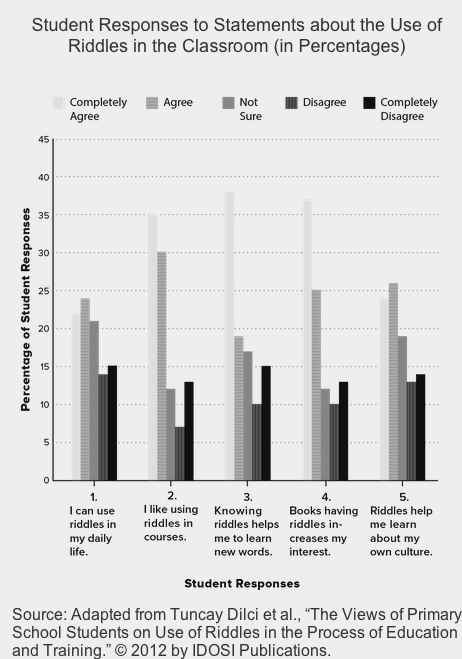Questions 1-11 are based on the following
passage.
This passage is excerpted from Carly Wood, Valier Gladwell and Jo Barton, “A Repeated Measures Experiment of School Playing Environment to Increase Physical Activity and Enhance Self-Esteem in UK School Children.” © 2014 by Wood et al.
Questions of when, where, how, and with whom children's
riddles [are used] have been addressed in the folkloristic and
anthropological literature, but they have rarely been
answered in depth. Prior to the 1960s or so, collecting
5 standards allowed considerable latitude in the recording of
contextual and interactional data. Many researchers simply
ignored the information. Others sketched out basic
parameters, but too often their observations tended toward
the obvious and the dominant. For example, researchers have
10 tended to regard community members as a homogeneous
group, thereby assuming that whatever was true for adult
riddling held equally well for children's. Or, they viewed
children themselves as undiversified, thereby bypassing
differences in riddling due to youngsters' ages, or, in urban
15 areas, their ethnic heritage. Especially problematic has been
information about settings and interactional events that
encourage or inhibit riddling.
Despite this unevenness in the literature, enough
information is retrievable to at least hint at some cross-
20 cultural trends. As the first of these, we can identify two
broadly different tracks that communities take with regard to
the appropriateness of distinct groups' engaging in riddling.
First, there are groups that treat riddling as an activity open to
both adults and children. Among the Anang of Nigeria, for
25 instance, both adults and children may pose and answer
riddles. Secondly, and in contrast to groups like the Anang,
communities may limit active involvement according to the
age (or perhaps, the social status) of the potential
participants. In some cases, riddling is seen as an adult
30 prerogative. Though riddles may be posed occasionally to
children for specific purposes, such as testing the youngsters'
intelligence, they are not otherwise encouraged to participate.
As an alternative to across-the-board restrictions based on
age, other communities require children to simply remain
35 silent when riddling occurs in adult social events.
Within the literature, the most frequently reported
occasions of adult- child riddling are those involving
pedagogy* and leisure-time activity, respectively. In
pedagogic riddling, the adult takes on the role of teacher, the
40 child the role of student. The interactions can occur in the
home as well as in the school. To take the home environment
first: Among the Chamula of Central America, mothers may
use riddles in teaching their children to talk. In the Ozark
mountains of the United States in the 1930s, some parents
45 regarded "workin' out riddles" as an intellectual discipline for
children. They posed riddles to their children in the hope of
training the children's minds. Similar motives appear to have
been behind adult-child riddling in other areas of the United
States and in Europe. By far, the most frequent reports of
50 pedagogic riddling in the home come from Africa. There,
riddling is used to amuse children while testing their wit and
competence in culture-specific values. With respect to
pedagogic riddling in the school environment, several
curriculum reports have suggested that riddling in the
55 classroom can aid youngsters' development of perceptual and
descriptive skills. Although to my knowledge we have no
ethnographic reports of pedagogic riddling within the
mainstream classroom, there exists at least one report treating
riddle use in formal, non-English language instruction. Diane
60 Roskies studied classroom activities in Kheyder, a Jewish
primary school. There, a variety of verbal art forms were
applied in the teaching of the [Hebrew] alphabet. As one
example of the pedagogic play, the children were encouraged
to tell riddles dealing with the shapes of the letters.
65 In contrast to pedagogic riddling, leisure-time riddling is
pursued as an end in itself. Entertainment is the primary goal.
Generally speaking, leisure-time riddling between children
and adults develops in the vicinity of the home, when
practical obligations are few. Although parents and siblings
70 appear to be children's most frequent coparticipants,
youngsters confronted by more distant relatives and other
visitors may find that they can use riddling to communicate
across the "small-talk barrier." Of course, it is always
possible that this arrangement can backfire. Proud of their
75 "funny, clever" children, parents have been known to
encourage the youngsters to "perform" riddles for the parents'
friends.
*Pedagogy is the method and practice of teaching.